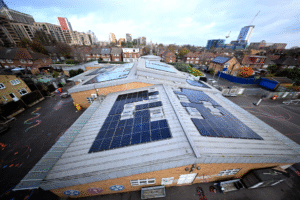Katie Rees, UK Head of Corporate, Power & Green, SEFE Energy shares practical insights into how organisations can adopt a proactive Net Zero approach.
The public sector is one of several priority targets for carbon reduction, with initiatives such as the Public Sector Decarbonisation Scheme in the UK, which recently entered a new ‘Phase 4’ to support more public buildings such as schools and hospitals to cut their emissions and accelerate to net zero.
The industry has a strong sense of the direction it needs to travel and of course, a clear mandate to do so, but it’s not uncommon for the prospect of reaching the end Net Zero goal to feel abstract and overwhelming.
Every different type of public sector organisation will have its own set of unique challenges when addressing net zero targets. What does unite the sector however is an imperative to effectively manage energy usage and utilities – this is a great starting point.
So, what can public sector organisations do now to manage energy today, with the aim of meeting future net zero goals? Understanding this element is a critical first step on that wider net zero journey.
Where does energy efficiency fit into Net Zero?
As we strive to achieve net-zero emissions, energy efficiency stands out as a key building block—an essential foundation upon which all our efforts must be built. Why is energy efficiency so important? Let’s consider the impact it has across several vital areas.
First and foremost, energy efficiency is about reducing energy consumption. By using less energy to accomplish the same tasks, we directly lower the overall demand for energy. This is a straightforward but incredibly powerful concept—by optimising our energy use, we take a significant step toward reducing our carbon footprint and save on costs in the process.
It may sound simple, but educating teams about smarter energy management is one of the most effective ways to set in place the core foundations needed to help reach net zero.
Energy efficiency also plays a crucial role in enhancing energy security. By decreasing our overall energy demand, particularly from non-renewable sources, we reduce our dependence on imported fuels. This makes us less vulnerable to global energy market fluctuations and strengthens our resilience in the face of geopolitical challenges.
As we reduce energy demand, it becomes easier to match supply from renewable sources like wind and solar. This supports a more sustainable and balanced energy grid, helping us transition away from fossil fuels more smoothly.
So, plenty of motivation to become more energy efficient, but where exactly to start? For us, it begins with data.
Data accuracy – the cornerstone of energy efficiency
To put it plainly, accurate data is absolutely essential for reporting, billing, and invoicing. In order to measure energy efficiency improvements, we need precise data to track energy consumption accurately. Without reliable data, we cannot provide accurate reports, which are necessary for transparent billing and invoicing processes. For both businesses and consumers, this accuracy ensures that energy costs are fairly calculated.
But data does more than just support billing processes. It also helps us understand trends and patterns in energy use, including leakages, enabling us to make informed decisions for the future. By analysing historical data, we can identify inefficiencies, pinpoint areas for improvement, and predict future energy needs – a key part of becoming more energy efficient.
Additionally, ensuring you have the right data now will set you up for future success when organisations are ready to invest in further technologies. Otherwise it can impact figures adversely going forward, reducing the benefits of utilising date in the first place.
Within the public sector, the importance of data extends to its impact on tenders and specific requirements for public organisations. Accurate energy data is often a key component in the procurement processes of public entities but it’s not uncommon for public sector organisations to be behind on their readings.
Conducting an audit is one of the most fundamental ways of improving energy efficiency. Understanding exactly where and how energy is being used means companies can review their energy usage comprehensively, making it easier to identify areas to reduce consumption.
Alongside data audits, the use of smart meters is equally powerful due to its detailed real-time consumption data, helping organisations adapt quickly to changing conditions. For example, demand response programs, supported by real-time data, enable companies to reduce or shift their energy usage during peak periods. This not only cuts costs but also eases the strain on the grid during high-demand times.
It’s important to note that meters vary by building size and location and there are many factors that can impact the accuracy of a meter, logger or even a more advanced energy management system (EMS). We once worked with a school whose EMS was showing unusual fluctuations despite the team being careful with their heating and lights. We eventually discovered that was due to a thermostat being placed close to a door that was constantly in use by the children and this was compromising the data.
Working with your energy partner to understand these factors, including the potential behaviours of those in the building, and also making sure to send in reads on a quarterly basis rather than rely on estimations is essential.
While governments, suppliers and businesses address wider policies and infrastructure that will prepare us for a future less reliant on fossil fuels, energy efficiency is one of the most effective tools we have now to work towards net zero goals.
Upgrading public buildings and infrastructure for energy efficiency is one of the most impactful steps we can take and this all begins with establishing that baseline of accurate data that will form the glue of our energy strategy.
SEFE Energy is a leading energy supplier, providing a comprehensive range of natural gas, electricity and low carbon energy solutions to over 50,000 customers within the European wholesale and retail energy markets
More features, case studies and industry insight:
Great expectations: 2025 in net zero, nature and local government
Your footprint here: digital advertising emissions and how to reduce them















